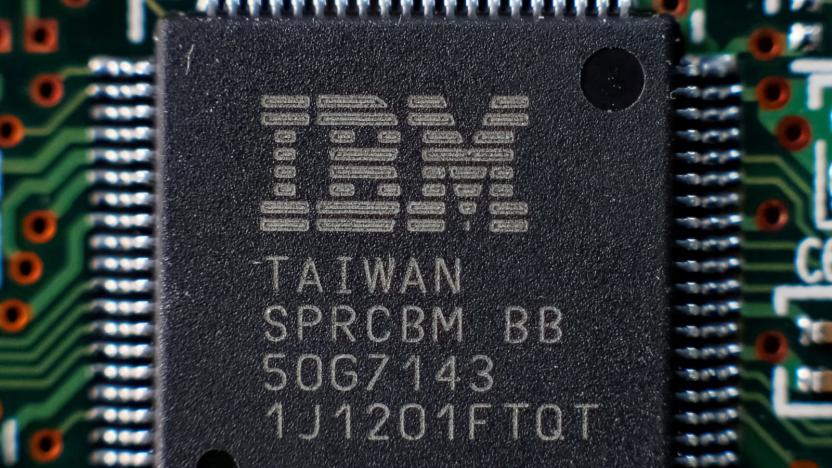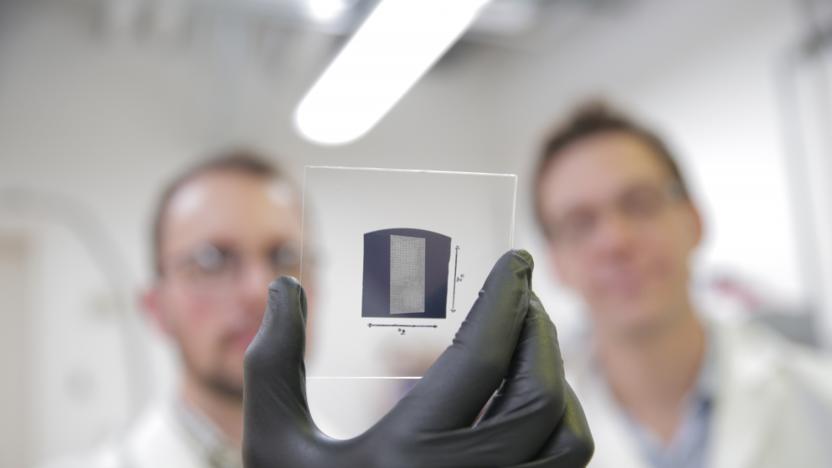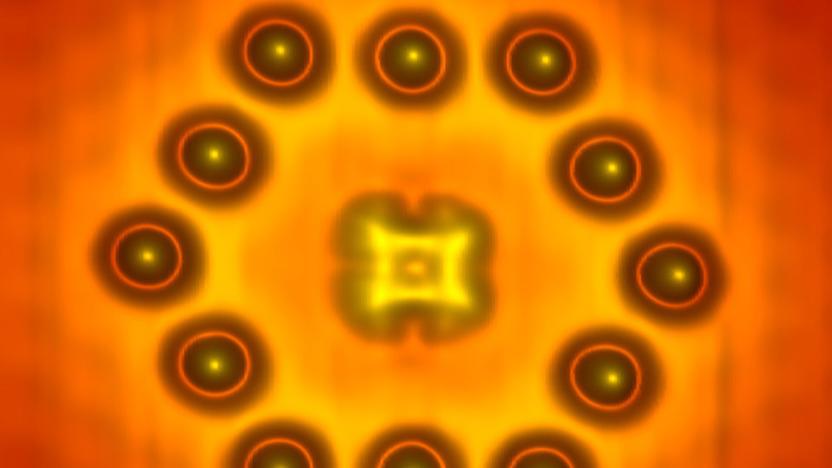transistor
Latest

Intel has a plan to go beyond 3nm chips
Intel revealed a rebrand of their node names, and an aggressive new roadmap that ends with inconceivably tiny 18-angstrom transistors.
Christopher Schodt08.04.2021
IBM's 2nm transistors matter because of their shape, not size
In the latest "mini" episode of our Upscaled explainer show, we dive into IBM's announcement that it had created 2nm transistors. Size, in this case, isn't the most important innovation.
Christopher Schodt05.11.2021
Will gallium nitride electronics change the world?
The semiconductor GaN has already changed the world once, it's at the heart of blue and white LEDs, but researchers are looking at how this materials could revolution power systems, space travel, telecommunications, and even processors.
Christopher Schodt07.02.2020
After a year of Epic Games exclusivity, ‘Hades’ heads to Steam Early Access
Hades, the next game from Bastion and Pyre developer Supergiant Games, is coming to Steam Early Access on December 10. The game has been available in early access on the Epic Games Store since December of last year.
Igor Bonifacic08.22.2019
Some of the best indie games ever are coming to Switch
It's clearer than ever that the Nintendo Switch is becoming the go-to console for indie game developers. Nintendo has unveiled launch plans for a spate of well-known indies in addition to launching a dedicated Indie Channel for news. You can expect classics like Undertale (September 18th), Supergiant's Bastion (Sept. 13th) and Transistor (November), the mobile hit Superbrothers: Sword and Sworcery EP (October), and the multiplayer chaos of TowerFall (September 27th, complete with characters from Celeste). And those are the more established games -- there are other hits on the way.
Jon Fingas08.28.2018
Super-thin semiconductors delay the 'death' of silicon
Silicon has been the backbone of processors for decades, but it's rapidly approaching its physical limits: making a chip on a process smaller than 5 nanometers is usually impossible without introducing problems. How is Moore's Law for chip complexity going to survive? Stanford researchers have a solution: augment it with materials that outdo silicon where it counts. They've pinpointed two semiconductors, hafnium diselenide and zirconium diselenide, that can be made extremely thin (just three atoms thick) while self-insulating far more effectively than silicon. You could get transistors that are 10 times smaller than the smallest you get from silicon alone -- 5nm chips would seem bloated compared to what's possible with these diselenides.
Jon Fingas08.13.2017
Log off now before today’s Steam’s summer sale leaves you broke
Your wallet is about to get a bit lighter. Or, if you lack self-control, a lot lighter. That's because over the next 13 days games on Steam will be marked down dramatically during this year's summer sale. The first crop includes up to half off the Final Fantasy franchise and 70 percent off underwater indie charmer Abzu. Hyper Light Drifter has been discounted by half as well, and if you wanted to explore Mafia III's version of the Luisiana bayou, now it'll only cost you around $15.
Timothy J. Seppala06.22.2017
IBM squeezes 30 billion transistors into a fingernail-sized chip
Who said Moore's Law was dead? Certainly not IBM or its chip partners Globalfoundries and Samsung. The trio has developed a transistor manufacturing process that should pave the way for 5-nanometer chips. While the team etched the chip using the same extreme ultraviolet lithography (EUV) used for the breakthrough 7nm chip, it ditched the common FinFET (fin field effect) transistor design in favor of stacks of silicon nanosheets. The switch makes it possible to fine-tune individual circuits to maximize their performance as they're crammed into an incredibly small space. How small? At 5nm, the group says it can squeeze 30 billion transistors into a chip the size of a fingernail (see below) -- not bad when the 7nm chip held 20 billion transistors a couple of years ago.
Jon Fingas06.05.2017
'Bastion' studio's 'Pyre' will be exclusive to PS4 and PC July 25th
Last we'd heard of the next game from Bastion and Transistor studio Supergiant Games, Pyre, there wasn't much to report in terms of concrete info. Today we have a bit more information, including when you'll finally be able to play it: July 25th exclusively on PC and PlayStation 4 and you can pre-order it right now for $20. The party-based role-playing game has some lofty narrative ambitions, too. Creative director Greg Kasavin writes on the PlayStation Blog that failure won't stop your progress through the game's story.
Timothy J. Seppala05.30.2017
Researchers push Moore's Law with a 1-nanometer transistor gate
Ready for some hardcore science about transistor elements that are a fraction of the width of a human hair? Good, because that's what this post is all about. "The semiconductor industry has long assumed that any gate below 5 nanometers wouldn't work, so anything below that was not even considered," University of California at Berkeley researcher Sujai Desay says. In recent years, though, that assertion has looked shaky, and now it's been thoroughly disproved thanks to the discoveries made by scientists at UC Berkeley and the magic of carbon nanotubes. Or, as they're more commonly known, graphene.
Timothy J. Seppala10.07.2016
Researchers think chaos theory can get us past Moore's Law
Gordon Moore, co-founder of Intel, believed that the number of transistors on an integrated circuit would double every year or two. And, to his credit, that rule pretty much held out between 1965 and 2015, when the laws of physics began to get in the way. Now, researchers at North Carolina State believe that we don't need to obsess over ever-smaller transistors to make chips even more powerful. Instead, they've turned to chaos theory in the hope that mixing things up will provide the performance boost that Intel can't.
Daniel Cooper09.26.2016
Carbon nanotube transistors promise faster, leaner processors
The computing industry sees carbon nanotube transistors as something of a Holy Grail. They promise not just faster performance and lower power consumption than silicon, but a way to prevent the stagnation of processor technology and the death of Moore's Law. However, their real-world speed has always lagged behind conventional technology... until now, that is. University of Wisconsin-Madison researchers have created what they say are the first carbon nanotube transistors to outpace modern silicon.
Jon Fingas09.05.2016
Roadmap says transistors will stop shrinking in 5 years
Whether or not Moore's Law on complexity has always held true, you've had one constant in the semiconductor world: chip makers would always find a way to shrink transistors and create more powerful chips without increasing size or power consumption. However, even that one hint of predictability might soon disappear. The Semiconductor Industry Association (which includes the likes of IBM and Intel) has published a roadmap which expects transistors to stop shrinking after 2021. Simply speaking, it might not be financial practical to keep reducing transistor sizes -- companies might not recoup the costs. Instead, they may focus on 3D chips an other technologies that make better use of available space.
Jon Fingas07.25.2016
Scientists design fast, flexible transistor for wearables
A team of University of Wisconsin-Madison researchers have devised a cheap method to make impressively fast and flexible silicon-based transistors. Their technique involves using beams of electrons to create reusable molds of the patterns they want, as well as a very, very tiny knife to etch minuscule trenches into those patterns. The result is a small, bendy transistor -- though not as small as a the Navy's single-molecule design -- that can transmit data wirelessly and has the potential to operate at a whopping 110 gigahertz. In other words, it's capable of some extremely fast computing and could lead to wearables a lot more powerful than those available today.
Mariella Moon04.21.2016
'Bastion' studio's third game, 'Pyre,' prepares to party in 2017
Pyre tells the story of three wanderers living in exile in a vast purgatory called the Downside, fighting for the chance to rejoin their homeland. They travel and battle in the Rites, a secret competition for those in exile who wish to be absolved, fighting together with a blend of magic and dexterity. While much of the game remains cloaked in mystery, it's due to hit PlayStation 4 and Steam simultaneously in 2017.
Jessica Conditt04.19.2016
'Plasmonics' could lead to super-fast optic communications
Researchers at Purdue University have developed a new kind of material that could improve the speed of optical communications by as much as 5000 times the current state of the art. The material is made of aluminum-doped zinc oxide (AZO) and it is able to change the amount of light it reflects by up to 40 percent while consuming a fraction of the power that conventional optical semiconductors consume. By reflecting more or less light, the material can encode and transmit data. What's more, this material operates in the near-infrared spectrum range, which is what is most commonly used in optical communications.
Andrew Tarantola08.03.2015
Intel's 3D memory is 1,000 times faster than modern storage
Intel and Micron unveiled a novel new kind of non-volatile data storage device during a press conference on Tuesday. The chips, dubbed "3D XPoint" (pronounced "cross-point"), are being touted as the first new class of "mainstream memory" to hit the market since 1989. These new chips could soon speed up everything from cell phones and SSD laptops to genomic sequencers and supercomputers.
Andrew Tarantola07.28.2015
Scientists make a transistor from a single molecule
You're looking at what could be not just one of the smallest semiconductor parts ever, but one of the smallest semiconductor parts possible. A worldwide research team has built a transistor that consists of a single copper phthalocyanine molecule, a dozen indium atoms and an indium arsenide backing material. The trick was to abandon the usual mechanics of a transistor, which normally controls current by modulating the gate voltage, in favor of a field effect. Here, you only need to vary the distance of the gate (in this case, the atoms) to modulate electricity.
Jon Fingas07.26.2015
Moore's Law in action: making our machines ever more micro
Over the past few decades, engineers have leveraged Moore's Law to the fullest, resulting in powerful ultrathin laptops and feature-rich miniature wearables. Back in 1981, a 23-pound Osborne 1 computer was considered portable, with 64KB of onboard memory. Today, smartphones weigh just a few ounces and easily pack 128GB of storage. There's also a vastly more complex architecture of circuits and sensors inside these devices, all at a scale nearly invisible to the eye. It's taken us decades to develop and shrink down these microelectronics to where they are today, which is no small feat. Join us as we ride the ever-shrinking gadget wave from its early days to some of the nanoscopic creations at work today.
Jon Turi06.13.2015
'Transistor' takes its sci-fi swordplay to iPhone and iPad
Dig Transistor's blend of hack-and-slash action, role-playing elements, and sci-fi storytelling? You no longer have to sit down in front of your console or PC to give a shot. Supergiant Games has released Transistor as a universal app for both iPhones and iPads, so you can carry on the adventures of Red and her giant, intelligent sword when you're on the move. The mobile title has a new touch-oriented control scheme, although there's also an optional "Classic Controls" option if you'd prefer gamepad-like input. There's no mention of an Android version, but we wouldn't count on one when Bastion hasn't received an Android port so far.
Jon Fingas06.12.2015